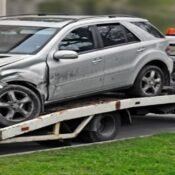What Happens to Your Car After Removal? The Recycling Process Explained

What Happens to Your Car After Removal? The Recycling Process Explained
Did you know that your old car can do more than just take up space in your driveway? Every year, thousands of vehicles reach the end of their road. Instead of letting them rust away, there’s a sustainable option: recycling. Car recycling not only helps reduce waste but also contributes to resource conservation. When you choose cash for cars West Perth or explore options like unwanted car removal Perth, you’re making a decision that benefits both the environment and your wallet.
Curious about what happens after you say goodbye to your vehicle? Let’s dive into the fascinating journey of car recycling!
How is a Car Recycled?
Car recycling is a careful process that transforms an unwanted vehicle into reusable materials. It begins once the car arrives at a recycling facility, often after being picked up through services like WA Fast Car Removal.
- First step involves dismantling the car, where technicians remove parts that can be resold or reused. This includes components such as engines, transmissions, and electronics.
- Next comes draining all fluids to eliminate any potential environmental hazards. Fluids like oil, coolant, and fuel need proper disposal methods to safeguard our ecosystem.
- After dismantling, sorting follows. Different materials—metals, plastics, glass—are separated for further processing. Each material type has its own recycling method tailored for efficiency.
- This systematic approach ensures maximum recovery of valuable resources while minimizing waste in landfills and reducing pollution associated with new material production.
Step 1: Dismantling and Draining Fluids
Once a car arrives at the recycling facility, the first step is dismantling. Skilled technicians begin by removing valuable components like batteries, catalytic converters, and electronics. These parts can often be reused or resold.
Next comes draining fluids. Cars contain various liquids that need careful handling to prevent environmental contamination. Oil, coolant, brake fluid, and fuel are carefully extracted from their respective systems.
This process not only ensures safety but also prepares the vehicle for further recycling stages. By managing these hazardous materials responsibly, recyclers help protect local ecosystems.
Dismantling is an intricate task requiring expertise and precision. It lays the groundwork for effective material recovery while prioritizing both human health and environmental safety in every action taken.
Important Read: Top Reasons to Choose Car Removal in North Perth for Scrap Vehicles
Step 2: Sorting Materials for Recycling
Once the dismantling process is complete, it’s time to sort through the various materials. This step is crucial for ensuring that each component ends up in the right recycling stream.
The recyclable parts of a vehicle include metals like steel and aluminum. These are often separated from plastics and other non-metallic materials. By identifying these categories, recyclers can maximize efficiency and minimize waste.
In addition to metals, components such as glass, rubber tires, and electronics require special attention. Each material type has its own recycling method, making accurate sorting essential for effective processing.
Skilled workers or advanced machinery typically handle this task. Their expertise ensures that nothing valuable goes to waste while keeping hazardous substances out of landfills. This meticulous approach sets the stage for responsible recycling practices moving forward.
Step 3: Shredding and Separating Metals
Once the dismantling and sorting processes are complete, it’s time for the exciting part: shredding. Heavy-duty machinery takes center stage in this phase.
The whole car is fed into a shredder, which tears it apart into small pieces. This method helps break down various components quickly and efficiently. The result? A mix of metal fragments and non-metal materials all jumbled together.
Next comes separation. Powerful magnets come into play to pull out ferrous metals like steel and iron from the shredded material. Non-ferrous metals such as aluminum are separated using advanced techniques like eddy current systems, ensuring that no valuable material goes to waste.
This meticulous process not only maximizes recycling but also minimizes environmental impact by keeping harmful substances away from landfills. It highlights how important effective metal recovery is in protecting our planet while repurposing resources effectively.
Step 4: Processing Non-Metallic Parts
Once the metals have been extracted, attention shifts to non-metallic parts of the car. These components include plastics, rubber, glass, and upholstery.
Each material undergoes specialized processing to ensure it is recycled effectively. For instance, plastics are sorted by type and then shredded into small pieces. This makes them easier to melt down for reuse in new products.
Rubber from tires is often processed into crumb rubber or used in asphalt mixtures for roads. Glass can be crushed and repurposed as cullet for manufacturing new glass items.
Upholstery materials like fabric may find a second life through textile recycling programs or even transformed into insulation products.
This careful handling of non-metallic parts minimizes waste and maximizes resource recovery within the automotive recycling process.
Benefits of Choosing a Certified Recycler
Choosing a certified recycler ensures that your car is handled with care and expertise. These professionals follow strict regulations and best practices, which means your vehicle will be dismantled safely.
A certified recycler prioritizes environmental responsibility. They properly dispose of hazardous materials like batteries and fluids, reducing pollution risks significantly. This commitment protects both the ecosystem and public health.
Moreover, working with a certified service guarantees you get fair value for your scrap car. They assess its worth accurately based on various factors, including parts that can be resold or recycled.
You also benefit from reliable customer service throughout the process. Certified recyclers aim to make car removals smooth and hassle-free. Their expertise leads to quicker transactions without compromising quality or safety standards.
Choosing a certified recycler adds peace of mind knowing you’re making an environmentally friendly choice while receiving instant cash for scrap cars in Perth.
Conclusion
Car recycling plays a crucial role in reducing waste and conserving resources. When you choose to recycle your vehicle, you’re not just getting rid of an unwanted car; you’re contributing to a more sustainable future.
Choosing certified recyclers ensures that your scrap car removal aligns with environmental standards. This decision supports local economies and promotes responsible disposal practices within Perth’s vibrant automotive community.
When considering options like cash for cars West Perth or unwanted car removal Perth, remember the importance of what happens after your vehicle leaves your driveway. By opting for reputable services such as WA Fast Car Removal or instant cash for scrap cars Perth, you’re making a choice that’s beneficial both financially and environmentally.
Your old car has the potential to make a significant impact beyond its years on the road. Embrace this opportunity by working with professionals who prioritize eco-friendly practices in their operations.
Recent Posts
Scrap Car Removal Albany | Free Pickup & Instant Cash Offer
Sell Your Car for Cash in Fremantle – Fast, Easy & Hassle-Free
Midland’s Fast Cars Solution – Sell Your Car in Minutes!
All Categories
- Auto Removal Services
- Car Removal Perth
- Cash For Car Removals
- Cash for cars Armadale
- cash for cars Busselton
- Cash For Cars East Perth
- Cash for Cars Ellenbrook
- cash for cars in Fremantle
- Cash for Cars in Midland
- Cash for Cars Joondalup
- Cash for Cars Mandurah
- Cash For Cars Midland
- Cash For Cars North Perth
- Cash For Cars Perth
- Cash For Cars Rockingham
- Cash For Cars South Perth
- Cash For Cars West Perth
- Cash for Cars Yanchep
- Scrap Car Removal
- Scrap Car Removal in Albany
- Scrap Cars in Perth
- Sell Car in North Perth
- Unwanted Car in Fremantle
- Unwanted car removal Perth




